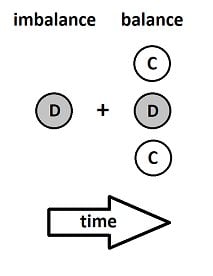This page is a permanent link to the reply below and its nested replies. See all post replies »
SomeMichGuy · M
@SW-User
Hmmmm...ok, what do you mean by
1) an "event" and its creation or destruction?
2) "creation efficiency level"? How would / could / does one measure that?
3) "balance" and "imbalance", and how does the plus sign figure into it?
Hmmmm...ok, what do you mean by
1) an "event" and its creation or destruction?
2) "creation efficiency level"? How would / could / does one measure that?
3) "balance" and "imbalance", and how does the plus sign figure into it?

SW-User
@SomeMichGuy Creation must match destruction. Otherwise the cosmos would be empty or full. It's a law for an infinite cosmos. There are two ways to depict a balanced relationship. Both are right, and I shared the one where afterliife is viable.
SomeMichGuy · M
Ok...that does not really explain your terminology, which is crucial to understanding your argument in the manner in which you mean it. E.g., "event" has a precise meaning in relativity, and you have used that and other terms which are clearly important to your notion(s)...which is why I asked about them.
I. RE:
A) Static universe?
It seems that you are arguing for a static universe. Is that correct?
B) Rates?
Do you mean that the rates of creation and destruction have to be equal?
C) Initial condition?
If I'm understanding your argument, this implies that you posit a fully-populated universe--like the one we see about us--as a necessary initial condition of your theory. Is that accurate?
II. RE:
A) "Law"?
Your notion is a new fundamental law of nature, then, right?
B) Alternative theory?
Given the above, you are proposing a new theory as an alternative to existing scientific notions of the universe--is that correct?
C) "Infinite cosmos"?
To refine a prior question, you require an infinite, fully-populated cosmos as an initial condition to your theory?
III. RE:
A) "Balance"?
Given what you are saying, I'm going to go out on a limb and ask if your diagram is "balanced" because you have
2 D's
2 C's
(which I assume must mean Destruction and Creation "events", if I am understanding you thus far)‐‐is that correct?
B) "Two ways"?
Why are there only "two ways" to depict a "balanced" relationship?
Forgive me if I am abusing your ideas/terminology and diagram--and I'm not sure how time enters in, or if I'm using your plus sign correctly--but wouldn't
D + C
be both "balanced" and the simplest such expression?
Wouldn't a generalization of your diagram
D + { (N - 1)D's with N C's}
all be balanced for
N = 1, 2, 3, ...
??
IV. RE:
A) "Afterlife"?
Again, understanding what you mean by this is crucial to understanding your argument; I think Dyson argued, in part, about worldline diagrams when he was pushing his ideas about how existing science could provide for an "afterlife" in some sense.
B) "Viability"?
If you are taking death as a possible destruction event, is your basic claim that your "law" requires that death have balancing new creations (and another destruction) in order to maintain "balance"?
C) A philosophical theory?
This is where your theory involves the "intangible" and is a theory of "afterlife" as a part of nature due to your new "law", if I am putting together your various statements here.
Does that sum it up properly, at least in broad outline?
I. RE:
Creation must match destruction. Otherwise the cosmos would be empty or full.
A) Static universe?
It seems that you are arguing for a static universe. Is that correct?
B) Rates?
Do you mean that the rates of creation and destruction have to be equal?
C) Initial condition?
If I'm understanding your argument, this implies that you posit a fully-populated universe--like the one we see about us--as a necessary initial condition of your theory. Is that accurate?
II. RE:
It's a law for an infinite cosmos.
A) "Law"?
Your notion is a new fundamental law of nature, then, right?
B) Alternative theory?
Given the above, you are proposing a new theory as an alternative to existing scientific notions of the universe--is that correct?
C) "Infinite cosmos"?
To refine a prior question, you require an infinite, fully-populated cosmos as an initial condition to your theory?
III. RE:
There are two ways to depict a balanced relationship.
A) "Balance"?
Given what you are saying, I'm going to go out on a limb and ask if your diagram is "balanced" because you have
2 D's
2 C's
(which I assume must mean Destruction and Creation "events", if I am understanding you thus far)‐‐is that correct?
B) "Two ways"?
Why are there only "two ways" to depict a "balanced" relationship?
Forgive me if I am abusing your ideas/terminology and diagram--and I'm not sure how time enters in, or if I'm using your plus sign correctly--but wouldn't
D + C
be both "balanced" and the simplest such expression?
Wouldn't a generalization of your diagram
D + { (N - 1)D's with N C's}
all be balanced for
N = 1, 2, 3, ...
??
IV. RE:
Both are right, and I shared the one where afterliife is viable.
A) "Afterlife"?
Again, understanding what you mean by this is crucial to understanding your argument; I think Dyson argued, in part, about worldline diagrams when he was pushing his ideas about how existing science could provide for an "afterlife" in some sense.
B) "Viability"?
If you are taking death as a possible destruction event, is your basic claim that your "law" requires that death have balancing new creations (and another destruction) in order to maintain "balance"?
C) A philosophical theory?
This is where your theory involves the "intangible" and is a theory of "afterlife" as a part of nature due to your new "law", if I am putting together your various statements here.
Does that sum it up properly, at least in broad outline?


